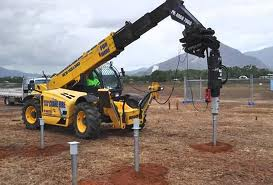Pile Capacity Calculation

Description
Details:
Soil Details
Unit weight of soil (gamma)
For undrained soils use phi' = 0
Angle of friction (phi')
Adhesion Factor
Angle of friction between pile and soil
Depth to Water Table
Pile Details
?=Square, ?=Circular
Diameter of pile
Depth to base of pile
Applied load - includes weight of pile
Pile Capacity
Bearing Capacity Factors
Overburden stress
Base Bearing Capacity
Shaft skin friction
Results
Vertical Load
Base Resistance
Shaft Resistance
Total ultimate resistance
Allowable Load
Overall factor of safety
Calculation Reference
Pile design
Geotecnics
Pile Design and Construction Practice
Pile capacity calculation involves determining the load-carrying capacity of a pile foundation. The capacity of a pile is derived from two main components: the end-bearing capacity at the pile tip (Qb) and the skin friction along the pile shaft (Qs). The total pile capacity (Qt) is the sum of these two components:
Qt = Qb + Qs
Here's an outline of the process for calculating pile capacity:
-
Determine pile dimensions and properties: Obtain the pile type (e.g., driven, bored, or CFA), its length, diameter or cross-sectional area, and material properties (e.g., concrete or steel).
-
Conduct a site investigation: Perform a geotechnical investigation to determine the soil properties along the pile length, such as soil type, unit weight, undrained shear strength (cu), angle of internal friction (φ), and soil bearing capacity.
-
Calculate end-bearing capacity (Qb): The end-bearing capacity depends on the soil properties at the pile tip and the pile's cross-sectional area (Ap). For example, in granular soils, the end-bearing capacity can be calculated using the following formula:
Qb = Ap * Nq * q
Where:
- Nq is the bearing capacity factor, which depends on the soil's friction angle (φ)
- q is the effective vertical stress at the pile tip
In cohesive soils, the end-bearing capacity can be calculated using the following formula:
Qb = Ap * cu * Nc
Where:
- cu is the undrained shear strength of the soil at the pile tip
- Nc is the bearing capacity factor, which depends on the pile type and installation method
-
Calculate skin friction capacity (Qs): The skin friction capacity depends on the soil properties along the pile shaft and the pile's surface area (As). For each soil layer, calculate the skin friction (fs) and multiply it by the pile's surface area in that layer. Then, sum the skin friction capacities of all layers to obtain the total skin friction capacity (Qs).
-
Calculate the total pile capacity (Qt): Add the end-bearing capacity (Qb) and the skin friction capacity (Qs) to obtain the total pile capacity:
Qt = Qb + Qs
- Apply a factor of safety (FS): Divide the total pile capacity (Qt) by a factor of safety to obtain the allowable pile capacity (Qa):
Qa = Qt / FS
The factor of safety typically ranges from 2 to 3, depending on the project requirements, level of uncertainty, and reliability of the pile capacity estimation.
This simplified approach provides a general method for calculating pile capacity. In practice, more advanced methods, such as dynamic or static load tests and numerical modeling, may be required for complex situations or where more accurate predictions are needed. It is always recommended to consult with experienced geotechnical engineers when determining pile capacity.
Calculation Preview
Full download access to any calculation is available to users with a paid or awarded subscription (XLC Pro).
Subscriptions are free to contributors to the site, alternatively they can be purchased.
Click here for information on subscriptions.




